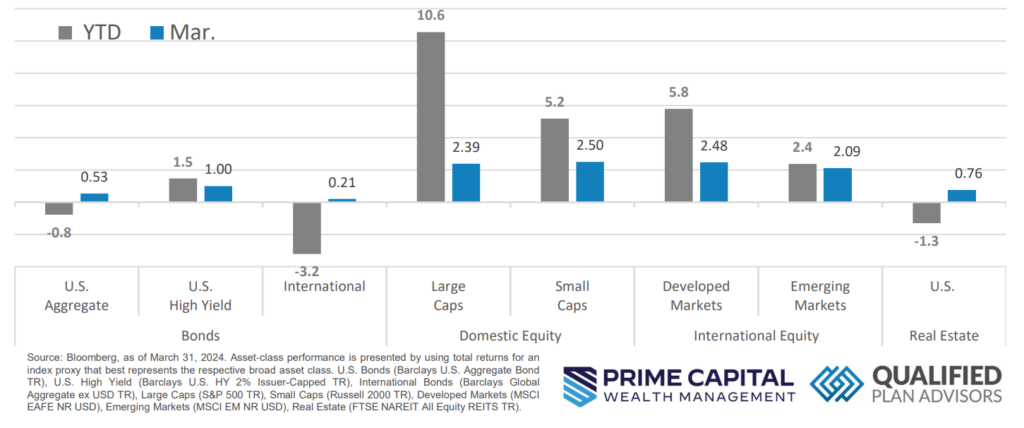Quick Takes:
- Risk Assets Extended Their Upward Climb. All asset classes listed notched positive gains in March, helping pull year-to-date (YTD) figures for Real Estate, U.S. Aggregate Bonds, and International Bonds closer to positive territory.
- Inflation Eases in February. The Fed’s preferred inflation gauge, the PCE Deflator, saw a welcome slowdown in February, rising just 0.3% after a stronger January increase. This tamer reading contrasts with other inflation measures, which had suggested intensifying price pressures earlier in 2024.
- The Dollar Rallied Behind Poor Inflation Data. Disappointing inflation data triggered a rally in the dollar. This data strengthens the argument for the U.S. central bank to maintain current short-term interest rates, postponing any potential cuts.
- Labor Markets and Unemployment Rate. February’s strong jobs report hides a weaker market. Unemployment rose despite gains in just a few industries. Analysts see this as a trend, predicting a possible rate cut by the Fed in May to stimulate the economy. This could signal a slowdown for the economy.
Asset Class Performance
While Risk Asset Classes saw returns moderate in March compared to February, they maintained their positive trajectory following a sluggish start to the year. Leading the pack in March were Small Caps, Large Caps, and both Developed and Emerging Markets. Real Estate and the U.S. Aggregate Bond Market continued their ascent towards positive territory for the year on the back of a strong March performance.
Markets & Macroeconomics
February’s headline jobs report initially looked positive but revealed a different story with a closer look. While the headline number suggested strong hiring, the gains were concentrated in just a few industries. More importantly, the unemployment rate rose unexpectedly. This increase aligns with other indicators, like the household employment survey, which point to a looser labor market than previously thought. Analysts believe the February report provides a more accurate picture and expect future data to reflect this. The jump in unemployment is particularly concerning because it’s driven by layoffs, even with a growing number of job seekers. This aligns with the lower “quits rate” from the January JOLTS report, indicating employees are staying put and companies are hiring less. Additionally, a reliable model predicts a sharper rise in unemployment due to weaker wage growth, a sign of less worker bargaining power. While the model might overestimate the increase, it suggests unemployment will likely climb higher than the Fed’s year-end projection of 4.1%. Other indicators like rising claims and job-cut announcements further support this view of a cooling labor market. Given the unexpected cool-down in the labor market, analysts predict the Fed might cut interest rates sooner than anticipated. They expect a cut in May, as opposed to the current market expectation of June. The Fed has historically reacted quickly to negative labor market data, and this shift in perspective could influence their policy decisions. An earlier rate cut could be implemented to stimulate the economy.
Bottom Line: The Federal Reserve is facing a complex economic picture. While there’s positive news with inflation showing signs of decline, particularly in core spending prices, it’s not enough for them to consider lowering interest rates just yet. They’re looking for a clearer trend of sustained inflation reduction. However, the broader US economy seems to be on strong footing. Recent data shows significant growth in both GDP and GDI, indicating the economy is expanding at a healthy rate. Additionally, a narrowing gap between these two figures, which is important for gauging recessions, points towards a more optimistic outlook for the US.



